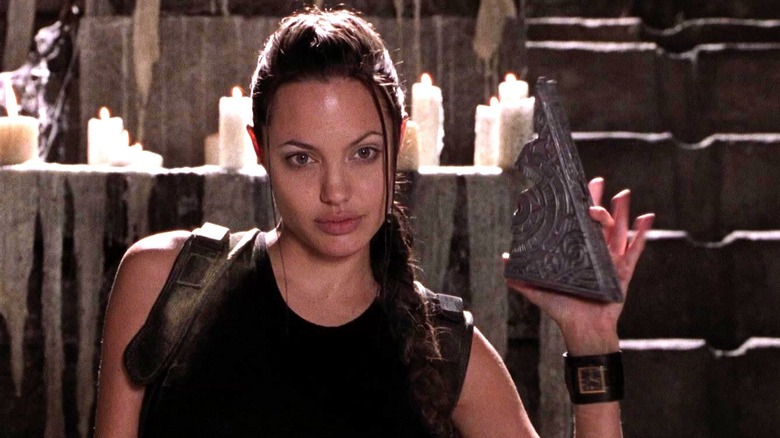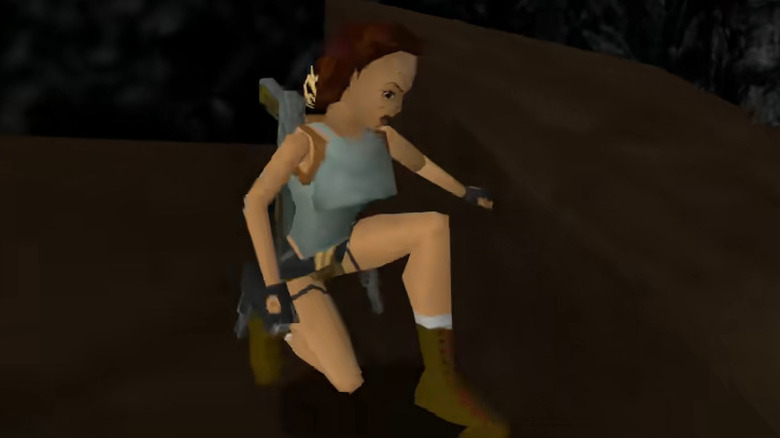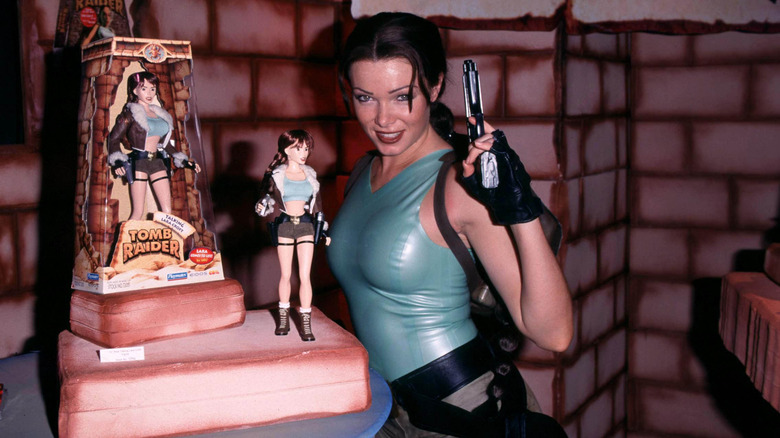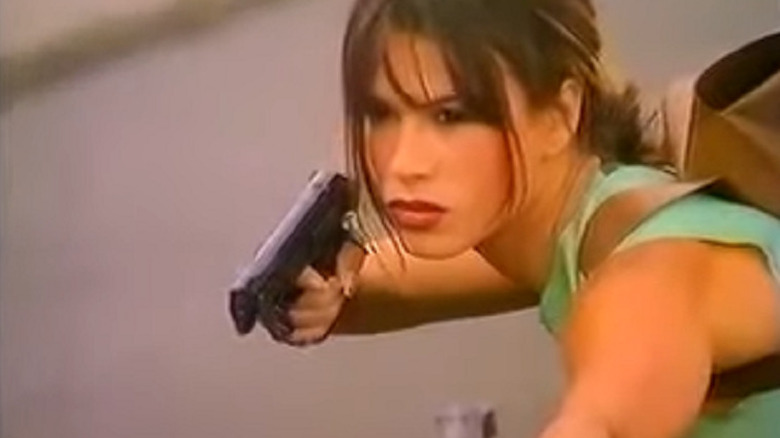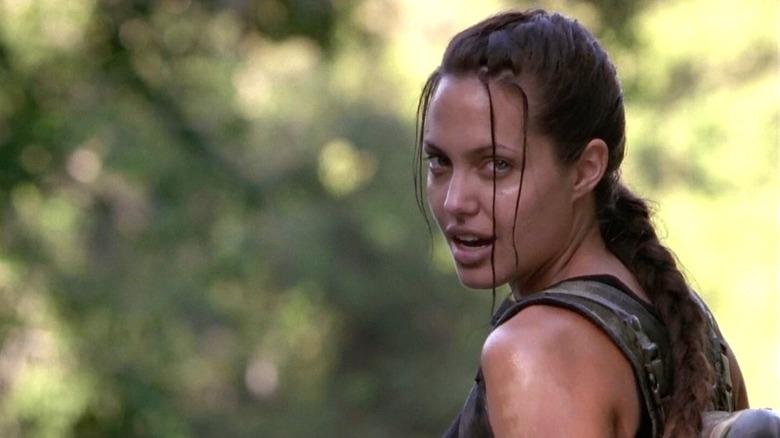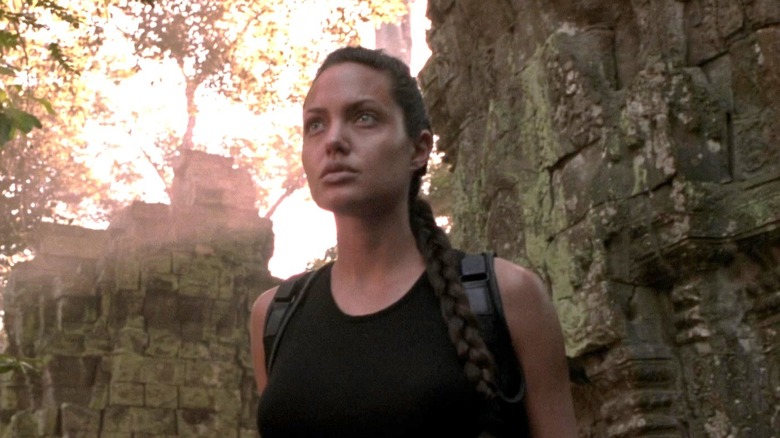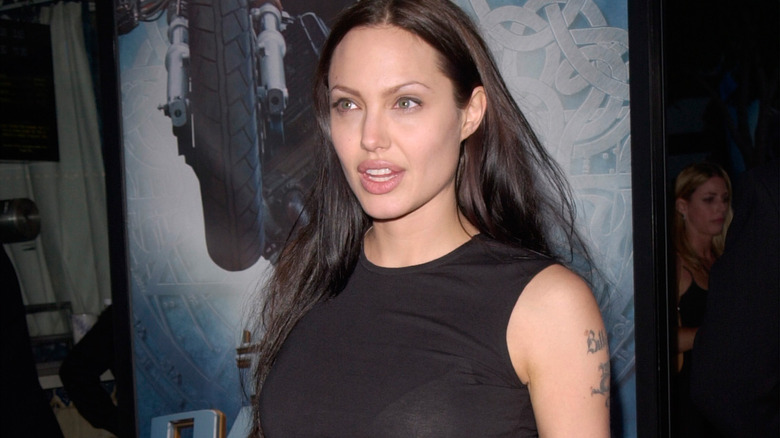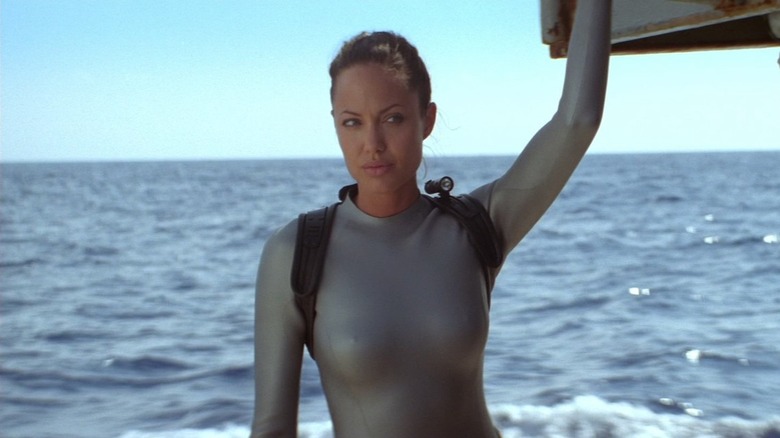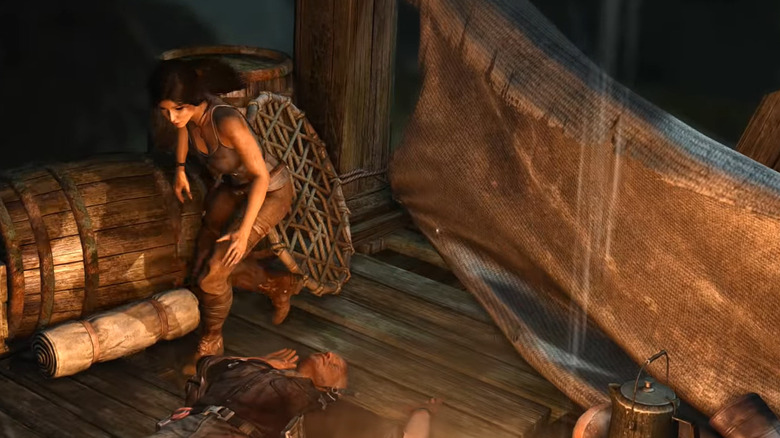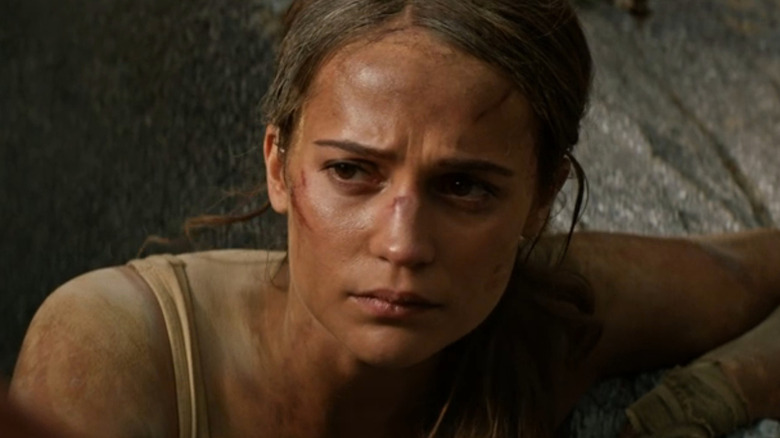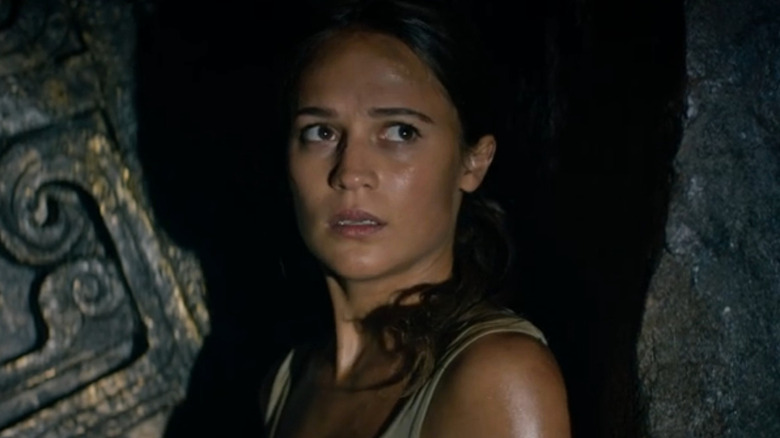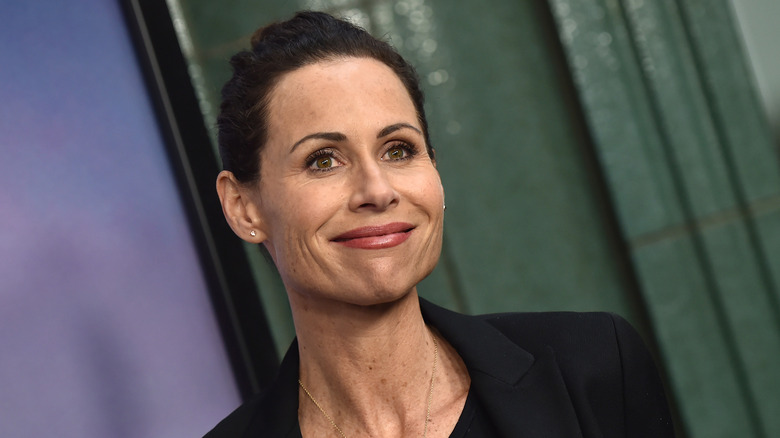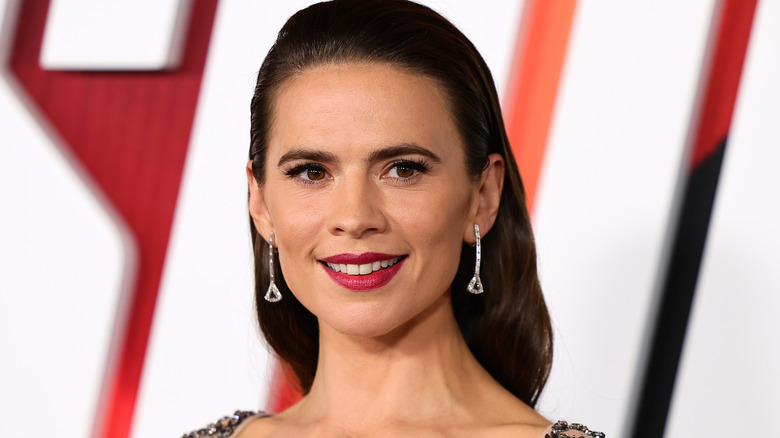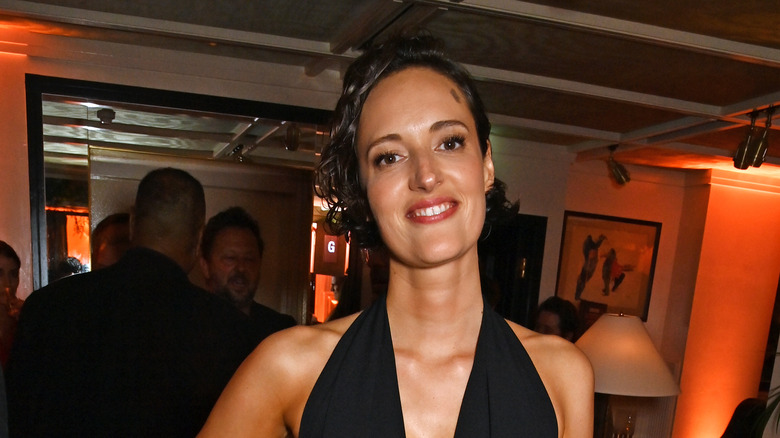The Real Reason 3 Actresses Have Played Lara Croft In The Last 20 Years
20 years is a long time to be an action hero, so perhaps it is understandable that many different actresses have been responsible for bringing Lara Croft to life. An action-adventure character on par with Indiana Jones and James Bond when it comes to their charm, travel budget, and near-superhuman survival abilities, Lara has delighted fans since her debut in the mid-'90s.
Lara has enjoyed a lengthy career across games, movies, TV shows, and comics, and she shows no signs of stopping now. The character rose to pop culture prominence in the '90s — perhaps as much for her physical appearance as her quick-thinking and butt-kicking abilities. Over the years, however, Lara Croft has undoubtedly evolved in terms of her character and look.
The video game version of Lara has been voiced by a number of talented actresses, and in her major film and TV appearances three prominent actresses have brought her to life: Angelina Jolie, Alicia Vikander, and now, Hayley Atwell. We take a look at what it is about Lara Croft that draws stars to her like moths to a flame, or Lara to a tomb.
The birth of Lara Croft
Lara Croft made her first appearance as the protagonist of the 1996 video game, "Tomb Raider." The game features ground-breaking 3D animation, as well as a female action hero — rare for major studios and game publishers to champion at any time. In this first iteration from British game company, Core Design, Lara Croft is witty and athletic and this sets the tone for the character — for better and worse.
In the game, Lara is an aristocratic archeologist hired to steal an artifact — called the Scion — from a secret tomb in Peru. The double-gun-wielding, short-shorts-wearing hero outsmarts booby traps, traitors, and monsters before destroying the artifact to save the world. Sound like any other archaeologist-adventurers with a penchant for property damage that you know? "I was a fan of movies such as 'Tank Girl', 'Indiana Jones' and 'Hard Boiled' — the John Woo film. These helped give me the idea for Lara," Toby Gard, the creator and initial designer of Lara Croft, shared with the BBC in 2001.
"The idea was to create a female character who was a heroine, you know, cool, collected, in control, that sort of thing," he told Game Developer. Of course, Gard also designed Lara with a hyper-sexualized figure. Lara's combination of action-hero skills and sex appeal fused to create a character that would go on to inspire women, as much as it would highlight the game industry's sexist stances on beauty standards and power.
The first Lara Croft models
The first "Tomb Raider" game was a smash hit in the gaming world, and a bit of marketing magic made Lara Croft a '90s household name. While the first game was developed by Core Design, it was published by Eidos Interactive. They aggressively marketed "Tomb Raider" to a primarily male audience by marketing Lara Croft herself, angling their campaigns on Lara's looks.
If Lara's game designers were trying to create an iconic female action-adventure hero with wit and smarts to match that of Indiana Jones, the marketing for the games seemed dead-set on objectifying her. A 1998 print ad features Lara in a come-hither pose, with a headline reading "What are you waiting for? See all that Lara has to offer." A 1997 ad called "Where the Boys Are" depicts a bored exotic dancer chewing gum in an empty club because the "boys" are all playing "Tomb Raider II."
Eidos Interactive also hired models to play Lara for marketing purposes, including Nathalie Cook, Rhona Mitra, Vanessa Demouy, and Nell McAndrew. These models appeared at in-person gaming events and conventions, on the covers of industry magazines, and were even offered as prizes in "win a night out with Lara" competitions (PC Zone magazine via Reddit). In 2012, Guinness World Records awarded Lara Croft with the prize for "Most official real-life stand-ins for a video game character," with 10 actors or models portraying her at that point.
Lara's early life in the spotlight
The early Lara had a sexy look but also intelligence, wit, and self-sufficiency, and this appealed to female gamers. In fact, in 2016 the BBC reported that early Eidos Interactive market research data showed 40% of Lara's initial audience was made up of women. Nell McAndrew was one of Lara's promotional models who played the adventurer at live events. "Everybody was just lovely," she tells Thrillist. "There would be families. There would be lots of males — mainly males. But lots of females as well ... People proposed to me."
In 2001, Eidos Interactive put out an official music album featuring Lara model Rhona Mitra singing as Lara, produced by Eurythmics member Dave Spencer. The album is called "Female Icon" and includes songs with titles like "Getting Naked" and "Rock Your Own World."
Even if the album wasn't a hit, the wildly popular character took on a life of her own. She was nominated to be an ambassador for British scientific excellence in 1998 and she graced the cover of Entertainment Weekly and The Face magazine. However, when McAndrew agreed to pose nude as Lara Croft for Playboy, Eidos Interactive fought it tooth and nail, claiming that such a centerfold would tarnish Lara's "squeaky-clean image" (per The Guardian). Lara Croft — in all her complicated glory — was going places and it wasn't long before the big screen beckoned.
Lara Croft goes to the movies
By 1998, the "Tomb Raider" game franchise was a proven hit. That same year, a movie went into development, kicking off the first of many attempts to bring the serialized success of her character to the big screen. The script went through many drafts, however, when director Simon West took over in 2000 after Stephen Herek dropped out, West went back to the first team that took a crack at the script: Patrick Massett and John Zinman. "It's the classic Hollywood development system where you go back to where you started," West told Entertainment Weekly in 2001.
Many actors were also almost cast as Lara Croft, but West had other ideas. "We don't want to ram a Hollywood star into this thing, because Lara is visually [known]," he said. When a front-runner for the role emerged, West made the controversial call on the actor who would bring Lara Croft to the big screen.
Angelina Jolie as Lara Croft
In 2001, Angelina Jolie was an edgy actress in more ways than one. Even though Jolie won a best supporting actress Academy Award for her work in "Girl, Interrupted" and gained praise for her performances in a number of films, she had not yet broken into lead roles. Jolie was, however, cast as a "bad girl" by the press.
Jolie caused a media frenzy when she kissed her brother at a Vanity Fair Oscars afterparty — but subsequently denied there was anything more than familial love between them — and made the headlines again for wearing a vial of then partner Billy Bob Thornton's blood around her neck. Director Simon West told Entertainment Weekly, "She brought this great Angelina Jolie mythology with her as this dark, crazy, wicked woman with a very particular and interesting personality. I wanted that mythology of Angelina Jolie to fuse with Lara Croft."
The fusion worked. 2001's "Lara Croft: Tomb Raider" was a critical failure, but a box office hit, and it proved that a "Tomb Raider" film franchise might be just as lucrative as the games. That success was largely down to Jolie's action-packed, emotionally engaged, and wickedly humorous portrayal of Lara.
Lara Croft raids Angelina Jolie's heart
While the "Tomb Raider" games and the first film traded hard on Angelina Jolie's sex appeal and off-screen persona, the training to play Lara Croft pulled something marvelous out of Jolie. The actress threw herself into doing stunt work headfirst and appreciated the strict regime required to play Lara Croft.
"I liked the intense training," Jolie said in a FeatsPress interview (via Cinema.com). Jolie also spoke positively about Lara's femininity and fearlessness, and how one does not negate the other. It's a powerful effect for a role to have on an actor — especially since she almost didn't play Lara at all.
Jolie told Collider in a 2021 interview that she initially turned down the role, thinking she and Lara weren't a fit. But when filmmakers encouraged her to train, she agreed. Jolie said "I would encourage anybody to do that. Sign up for as much as you can, give yourself a few months, push yourself to the limit, and see." In addition to Jolie finding playing the role of Lara Croft transformative, the first film was also shot in Cambodia — a country close to Jolie's heart, family, and filmmaking pursuits.
Jolie returned for the sequel in 2003
Even though "Lara Croft: Tomb Raider" was a box office success, the second one was given a smaller budget and a different director. Simon West wasn't Paramount's first pick to direct a sequel, and instead, cinematographer and director Jan de Bont was brought in for "Lara Croft: Tomb Raider: The Cradle of Life." Lara's sequel made less impact than the first film at the box office, and de Bont was vocal about studio meddling and the film's budget issues. "The very first day, we got a call ... 'By the way, you have to cut $12 million out of your budget.'" de Bont told Uproxx.
Perhaps production issues and aggressive tie-in marketing ploys — like a Lara Croft Jeep Rubicon — deterred Angelina Jolie from taking on a third installment. When asked about another sequel Jolie said "I just don't feel like I need to do another one, because I felt very happy with the last one" (via ScreenRant). Jolie had good reason to be happy leaving "Tomb Raider" behind. Lara Croft had made Jolie an action star in her own right, and more leading roles would follow.
The 2013 game reboot changed the game for Lara Croft
After the early popularity of the games, the "Tomb Raider" franchise was rebooted in 2013. The updated "Tomb Raider" represented a character-focused shift, as well as an updated look that takes Lara from '90s skin mags to more gritty realism — similar in style to "The Last of Us." "She's determined, caring, brave, empathetic, passionate and strong-willed, all of which come through during the gameplay and the narrative," lead writer Rhianna Pratchett told Game Developer in 2012. She added, "I was particularly keen to bring some warmth and empathy back to Lara, as I think that's something that's been rather lost over the years — particularly in the movies."
The game is an origin story and leans into Lara's vulnerabilities and character development more than previous games. Camilla Luddington took on the voice role — following in the footsteps of Shelley Blond, Judith Gibbins, Jonell Elliott, and Keeley Hawes — and her "Tomb Raider" character went on to directly inspire the next era of Lara Croft film and TV roles.
Tomb Raider with Alicia Vikander
Sharing little in common with her screen predecessors except for brown hair and indomitable strength, Swedish actress Alicia Vikander took over the role of Lara Croft in the 2018 film, "Tomb Raider." Largely inspired by the plot and tone of the 2013 "Tomb Raider" reboot game, it shows Lara becoming an action hero by confronting the truth about her father and the mysterious Japanese "Death Queen" Himiko.
The script for the 2018 "Tomb Raider" underwent rewrites by Geneva Roberston-Dworet, the co-screenwriter behind "Captain Marvel." Robertson-Dworet praised Vikander for her contributions to the character, telling We Live Entertainment that "[Before] It was very much an action-comedy and more like 'Indiana Jones' in tone. And Alicia came in and she really felt that it was important that it was more grounded and realistic in tone. And so we changed the tone of the script around her vision for it. She had a huge influence on it and it's very much her movie."
Vikander plays Lara Croft with emotion, sass, and cunning and her performance in the reboot bridges the gap between traditional action audiences and broader, gender-diverse audiences. Even though the critical reaction was lukewarm, "Tomb Raider" performed moderately well at the box office. Lara Croft — with Vikander as the titular hero — seemed poised to launch a film franchise yet again.
Vikander's Tomb Raider sequel gets dealt major setbacks
Studios were willing to let the new 2018 "Tomb Raider" franchise grow, despite the reboot's middling success. In 2021, Deadline announced that "Lovecraft Country" writer Misha Green would pen the script and mark her directorial debut with an Alicia Vikander sequel.
"I hope we go and make another movie. Because of the pandemic, we had plans of shooting this film, and now it's been one and a half years, but Misha Green is on board, and she's writing a draft right now," Vikander told Entertainment Weekly in 2021. Vikander was enthusiastic about collaborating with Green, adding: "It would be so amazing if we get to go and do this very big-ass film together, going to kick some ass in front of the camera and behind the camera, you know?"
Sadly, COVID delays and MGM's loss of copyright — coupled with the company's 2019 Amazon buyout — shuttered the project for Vikander's era. Deadline announced in 2022 that Vikander was no longer attached to the project. As of writing, no film franchise installment has been announced, despite rabid interest in the IP — and Vikander's stated interest in the role before the project fell out of her and Green's hands.
Tomb Raider TV adaptations
While big-screen adaptations of Lara Croft seem fraught with problems, she continues to thrive in video games, comics, and on TV. Minnie Driver even voiced Lara in a 2007 10-part animated series from GameTap called "ReVisioned: Tomb Raider."
The anthology-style series is a spin-off of sorts of one of Crystal Dynamic's Lara Croft timelines. The show has a pedigree of comics and animation talent behind it including, Peter Chung (creator of "Aeon Flux"), Gail Simone (comics writer whose work inspired "Birds of Prey"), and Christos Gage (comics and TV writer who worked on "Daredevil").
"World-famous writers and artists are each doing their own version of Lara Croft, telling a different story the way they see the character," Ricardo Sanchez, vice president of content for GameTap, told MovieWeb in 2007. While difficult to find online now, the fan site Raiding the Globe has preserved some stylish stills from "ReVisioned", which further prove that the character of Lara Croft can be interpreted in a range of artistic styles and tones.
Hayley Atwell's Lara Croft
The third high-profile actress to take on the Lara Croft mantle is Hayley Atwell, voicing Lara in Netflix's anime series, "Tomb Raider." Atwell is a talented actress who has done dynamic work in action films and dramas. She's also no stranger to playing in the sandbox of massive franchises, with memorable roles such as Peggy Carter in the Marvel cinematic universe, and Grace in "Mission: Impossible — Dead Reckoning Part One."
Perhaps the more intimate scope of a single TV show will give Atwell even more room to stretch her dramatic wings, and it is clearly a project she is excited about, telling The Movie Dweeb, "The scripts are fantastic, and I've loved doing it."
While not much is known about the plot for Netflix's "Tomb Raider," Tasha Huo ("The Witcher") is one of its lead writers. While initially set to come out in 2023, as of now, the show has no accessible Netflix preview page. Audiences will hold out hope that this means delay and not cancellation. As Huo says on her Twitter, "Animation takes a long time, y'all, but the wait will be worth it!"
Lara Croft: The Next Generation
So what does the future hold for Lara Croft? Lara has evolved over the last 20-plus years, so surely she can fight her way through 20 more. The role is an action star-maker for the actresses who portray her, and it is also proof that a strong, familiar character can handle new adventures and artistic interpretations. Lara Croft can draw new audiences while keeping old fans. Plus, if the video games continue to influence her character's arc, Lara Croft's world can only grow from here.
While Lara seems to be blessed with longevity and success, her movies and shows aren't always so lucky when it comes to project continuation. However, Phoebe Waller-Bridge is set to write a new "Tomb Raider" series for Amazon, and she's excited to put a fresh spin on a character she's loved since the early games.
"Having worked on 'Bond' and having worked as an actor on 'Indy', I feel like I've been building up to this," Waller-Bridge told Vanity Fair. "What if I could take the reins on an action franchise, with everything I've learned, with a character I adore, and also just bring back some of that '90s vibe?" With Waller-Bridge at the helm, the future looks bright for Lara Croft, and it is an adventure that audiences — and the character — are more than ready for.
